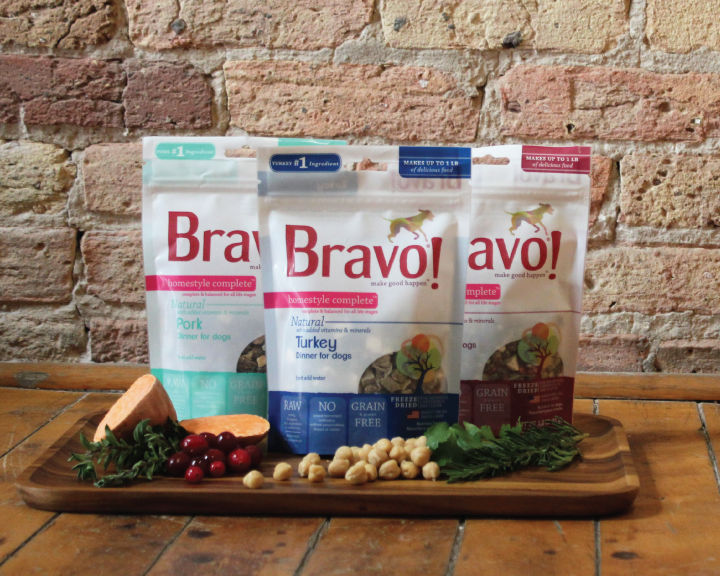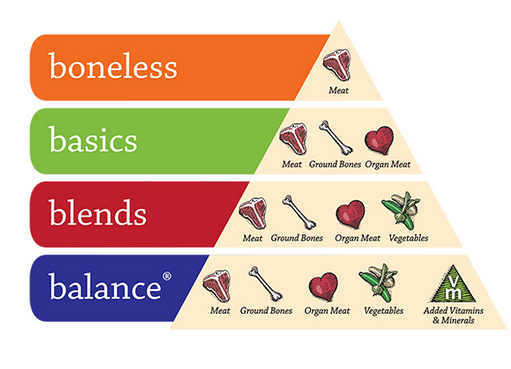The “what should I feed my pet” conversation is one of the most heated in the pet industry. Doesn’t matter who you ask (even non pet owners!), they are going to have their own very strong opinion on the subject. We met Bette Schubert, Bravo! co-founder and senior vice president of sales, new product development and education at a trade show last month and were impressed – not just by her passion (all pet business owners have that) but by her knowledge. We interviewed her about what she calls the “pet food hierarchy.”

Can you please explain your “pet food hierarchy” theory? What makes each “step” better than the one below it?
Schubert: In the hierarchy of foods, I would place raw, freeze dried and canned foods in the top three respectively.
Raw is the best option as it closely reflects the way dogs have eaten in the wild for centuries and provides our companion animals with what they need from a nutritional standpoint – meat, bone, organs – without all of the things they don’t need – grains, fillers, low grade meal, artificial preservatives and flavorings. Eating these high-quality meats and poultry provides not only delicious, but nutritious meals which aid in the overall health of our companion animals, as they contain plenty of nutrients and moisture.
Freeze died foods provide nutritional benefits which closely mirror fresh-frozen raw. The freeze drying process preserves the nutrients of the food while removing the moisture, eliminating the need for refrigeration. These foods need to be reconstituted prior to feeding, but once this is done, they do contain good levels of moisture. The freeze drying process is sometimes confused with dehydrating foods which is done at a higher temperature thus degrading some of the nutrients because you are essentially cooking them out of the food.
Like raw and freeze dried, canned foods also contain a lot of moisture making them a good choice for those pet parents who want a food requiring little to no preparation. Pet parents should look for canned foods that contain meat or poultry as the first ingredient, as well as some vegetables. Foods with grains should be avoided. Unlike raw and freeze dried, canned foods are cooked so some of the nutrients do breakdown in the cooking process.
Is there research to back up this hierarchy?
Schubert: There are many small studies that have been done, but there have been no large scale feeding studies. We are a relatively new and growing segment of the pet food business, so we expect those large studies that many veterinarians and animal health professionals want to see before they “believe,” will happen in the near future. That all said, the most important studies happen one at a time- as a dog or cat owner feeds raw and can see how it has benefitted their pet or solved a health issue and they become the advocates for feeding a raw diet. This kind of “seeing is believing” effect is why raw diets have grown so rapidly in acceptance and use.
What about the risks, say of salmonella in raw chicken versus cooked?
Schubert: Dogs are not humans and they have a very different digestive tract and process. Their digestive system is shorter, which means that foods are processed quickly before harmful bacteria has a chance to multiply and cause problems. So unlike us humans, most dogs can eat high quality raw meat without a problem. They are resistant – NOT immune – from the disease potential of these pathogens, and healthy dogs often harbor them without symptoms. Again, raw foods provide the most unadulterated nutrients while some of those vital nutrients are degraded by the heat from cooking.
A lot of people cite time and money when it comes to a reason for not doing raw (or even dehydrated/homemade) – what is the difference in cost compared to buying a premium dog food that’s say $50-60 for a 28-30lbs bag?
Schubert: There’s no doubt that raw foods tend to be a bit pricier based on the formula and protein you feed. However, when you look at the improvement in the overall health and well-being of the dog throughout their life span it’s worth the expense. Some of the benefits of feeding raw include:
- better weight control
- more energy
- healthier skin, coats and teeth
- better digestion
- less smelly stools
Benefits such as these can help prevent medical conditions and lessen the need for veterinary dental work, which can lead to cost-savings in the long run.
What make Bravo! different from others?
Schubert: There are a few things that set us apart from some of the others in our category beginning with our key philosophies of simplicity, value, quality, and choice.
We offer dog food and treats made from clean, wholesome meats and poultry. We believe less is more and our formulas are super simple by design, and only contain single proteins. We also include no more than four or five ingredients so pet parents always know exactly what their dogs are getting. This is great for pets with allergies. We never add grains, preservatives, chemicals, or artificial flavorings or colorings. Our foods are great alone and also provide a great foundation that can be easily customized if needed.

For us, value and choice go hand-in- hand. We have the industry’s widest range of protein choices – there are 10 in all – chicken, turkey, beef, lamb, pork, rabbit, salmon, duck, venison, and bison.
In terms of quality, all of our meats and poultry are of the highest quality and are sourced from reputable suppliers. Our red meats contain no hormones and poultry is antibiotic free. We source all of poultry here in the USA, while our beef and lamb come from the USA, New Zealand and Australia. We own and operate our own facility in Connecticut.
When we manufacture our product we always have safety and convenience in mind which has added to our success. Our burgers are individually vacuumed-sealed for freshness and safety and we offer resealable outer bags for our burgers and also for our treats.
What about convenience for pet owners? Isn’t raw food hard to feed?
Schubert: What has worked for us is offering our formulas in as many different formats as possible so that consumers can have the products their pets love in the format that is most convenient for them and offers them the greatest value. For example, our burgers are great and really convenient to use. They offer easy portioning and portability, while our “chubs” are great for families with large or multiple dogs. Our freeze dried line offers portability and convenience for those without a lot of freezer space.
You have new cans coming out, tell us about them and how they may help those how worry about time when it comes to feeding raw or dehydrated.
Schubert: Yes, we’re going to be releasing canned foods within the next several months. There will be six different varieties for dogs – three stews and three dinners. We’ve developed them to be as close to raw as possible with meat being the number one ingredient. If you look at the ingredient list you will not find any grains, potatoes, carrots or peas listed. The cans will be a good option for those pet parents who want the convenience of can feeding with the quality that has become synonymous with Bravo.
If someone must feed kibble, is there a “better way” to do so?
Schubert: The thing to remember with kibble is that it is a very dry food, so when it is consumed the pet is not receiving any hydration. One of the most important things to do is to be sure you are adding moisture. Adding vegetables or doing a combination of wet and dry are good ways to do this. Another option would be to add some water to your kibble and let it sit for a bit before serving. This helps to breakdown the food some so the body doesn’t have to work so hard. Crumbling some freeze dried product on top adds a little extra nutritional punch and can be a special treat for the dog. One caveat, use caution when mixing food or adding anything new into your dog’s diet. It should be done gradually so you can see if your dog has a reaction to any of the new foods. Making a slow transition also helps to prevent stomach upset.
Any advice to the pet parent researching dog foods?
Schubert: Keep your pet’s general health in mind – do they have any medical conditions, what is their activity level, do they have allergies? All of these things will have some bearing on the types of food pet parents will feed. Regardless of what food a pet parent chooses, it is important to note that they should vary the proteins they feed to their pets, as it not only provides variety for the pet’s palate to keep them from getting bored, but is also provides them with a complete nutrient profile, as each protein type delivers a slightly different nutritional benefits.

Feeding raw is a personal choice, but a decision we feel pet parents will be happy they made once they see the benefits of what good food can do for their dogs. If a pet parent is considering changing their dog’s diet, we suggest they take the time to do their homework. There are many options out there and they’ll want to find a brand and format that works best for their lifestyle.
While every dog is different, a good place to start is by talking with other pet parents to find out what brands they like and/or recommend. Your retailer can also be a great resource, as they will be able to highlight the differences among the brands out there. The important thing is to commit to feeding a better diet. Once you do, it’s easy to get into a routine that works for you. If there are pet parents who are considering a raw diet they should download a copy of Bravo Beginnings, our guide to feeding raw. It’s a quick read that is loaded with information they may find helpful in the decision making process. A free copy can be accessed at www.bravopetfoods.com.
